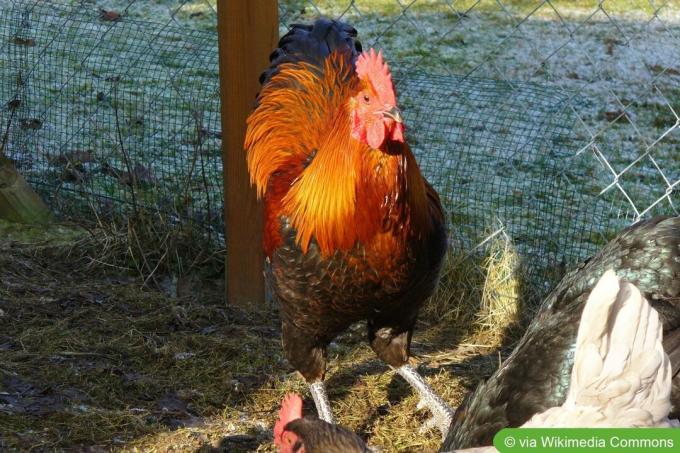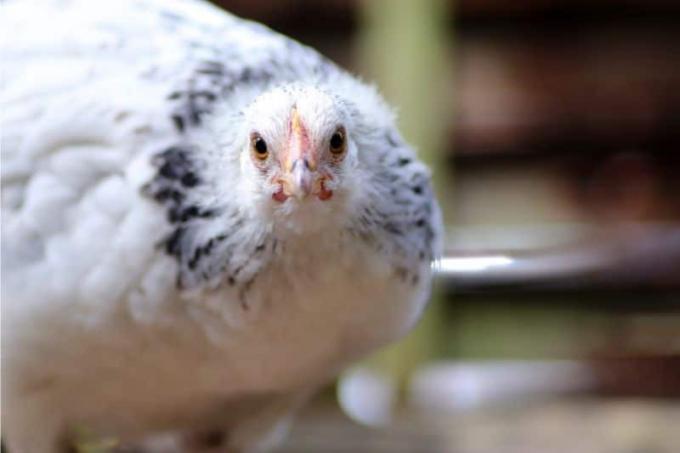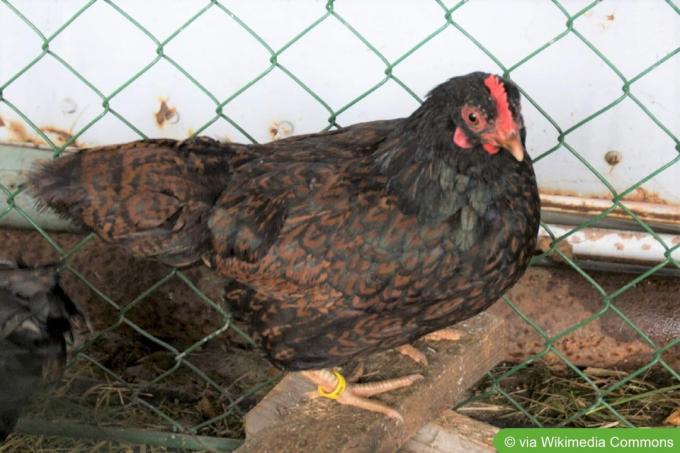

Table of contents
- German chicken breeds from A to D
- From H to L
- From S to U
- frequently asked Questions
More and more chicken keepers give preference to old German chicken breeds. They lay fewer eggs than hybrid chickens, but are more robust, more adaptable and impress with their special features. We present 15 old German chicken breeds.
German chicken breeds from A to D
Augsburger
Augsburg chickens can fly very well. If you ever see chickens sitting in a tree, they could be representatives of this breed.

- Weight cock: 2.3 to 3.0 kilograms
- Weight hen: 2.0 to 2.5 kilograms
- Laying performance: 170 to 180 eggs per year
- Egg color: white
- Plumage: black, blue-lined
- Comb and lobes: prominent red crown comb, long wattles, white earlobes
- Character: robust, friendly, trusting
- Endangerment: extremely endangered
A notice:
Augsburg chickens are among the rarest chicken breeds and are listed as "extremely endangered" on the Red List of the Federal Office for Agriculture and Food.
Bielefeld identification chicken
The Bielefeld Kennhuhn is one of the most popular chicken breeds. It convinces as a secondary use chicken with excellent meat and a high laying performance. Even in winter you can look forward to fresh eggs.

- Weight cock: 3.0 to 4.0 kilograms
- Weight hen: 2.5 to 3.0 kilograms
- Laying performance: 200 to 230 eggs per year
- Egg color: yellow-brown
- Plumage: Kennsperber, silver-kennsperber
- Comb and lobes: serrated single crest, long wattles, reddish earlobes
- Character: calm, trusting, robust
- Endangerment: under observation
German salmon chicken
Characteristic of this German chicken breed are its beard plumage and its five toes. While the salmon-colored hen lives up to her name, the dark-colored rooster might seem like a different breed.

- Weight cock: 3.0 to 4.0 kilograms
- Weight hen: 2.5 to 3.25 kilograms
- Laying performance: 150 to 160 eggs per year
- Egg color: light yellow to brown
- Plumage: blue-salmon, sparrow-salmon, white, white-columbian
- Comb and lobes: medium-sized serrated comb, short wattles and small earlobes overlaid by the beard
- Character: robust, low breeding instinct
- Endangerment: under observation
A notice:
German salmon chickens absolutely need a shelter to protect them from rain and cold.
German Sparrowhawk
Because the plumage of the medium-sized chickens is similar to that of the sparrow hawk, they got their name. German Sparrowhawks need a lot of exercise. They look diligently for food all day long, so that you can reduce the additional feeding when there is a lot of exercise.

- Weight cock: 2.5 to 3.0 kilograms
- Weight hen: 2.0 to 2.5 kilograms
- Laying performance: 180 to 200 eggs per year
- Egg color: white
- Plumage: barred
- Comb and lobes: small serrated crest, short wattles, small white earlobes
- Character: robust, easy to care for, lazy to fly
- Endangerment: endangered
German Langschan
German Langschan chickens are very heavy, so they prefer to spend the day on the ground. They could fly but don't want to. A high enclosure is therefore not necessary for this breed.

- Weight cock: 3.0 to 4.5 kilograms
- Weight hen: 2.5 to 3.5 kilograms
- Laying performance: 170 to 180 eggs per year
- Egg color: yellow-brown
- Plumage: black, white, blue-lined, brown-breasted
- Comb and lobes: Serrated single crest, wattles of medium length, reddish earlobes
- Character: undemanding, peaceful, trusting
- Endangerment: Critically Endangered
From H to L
hamburger
It is not quite certain whether the origin of the hamburger chickens really is in Germany. The English and Dutch also make claims. What is certain, however, is that the breed has been kept in Germany for generations.

- Weight cock: 2.0 to 2.5 kilograms
- Weight hen: 1.5 to 2.0 kilograms
- Laying performance: 170 to 200 eggs per year
- Egg color: white
- Plumage: blue-lined, gold-tipped, silver-tipped, gold-lacquered, silver-lacquered, black, white
- Comb and rags: rose comb, long red wattles, large white earlobe
- Character: low willingness to breed
- Endangerment: endangered
Tip:
The agile Hamburgers need a large outlet to feel comfortable.
Kraienkopp
Kraienkopp is an old German-Dutch breed of chicken. The chickens have the strange name because their head is said to resemble that of a crow.

- Weight cock: 2.5 to 3.5 kilograms
- Weight hen: 1.75 to 2.5 kilograms
- Laying performance: 180 to 190 eggs per year
- Egg color: white to light yellow
- Plumage: Blue-gold collared, Blue-silver collared, Gold collared, Silver collared, Orange collared
- Comb and lobes: small walnut comb, short wattles
- Character: courageous, roosters aggressive towards each other, friendly towards people
- Endangerment: under observation
A notice:
Because of their upright posture, Kraienkopp chickens appear proud and elegant. The roosters bravely assert themselves against birds of prey that attack them from the air. You can fly well.
Kruper
The Krüper is one of the oldest German chicken breeds. Already in the middle of the 16th The breed was mentioned in the 19th century. The name derives from the word "crawl" because the chickens have noticeably short legs. They are also known as creepers.

- Weight cock: 1.75 to 2.25 kilograms
- Weight hen: 1.5 to 2.0 kilograms
- Laying performance: 220 to 230 eggs per year
- Egg color: white
- Plumage: black, black and yellow, black and white, partridge-necked, barley
- Comb and lobes: large jagged crest, long wattles, large white earlobes
- Character: low brooding instinct, trusting, perfect family chicken
- Endangerment: extremely endangered
sheet fields
The Lakenfeld chickens come from near Osnabrück. The breed impresses with its high laying performance and tasty meat.

- Weight cock: 1.75 to 2.25 kilograms
- Weight hen: 1.5 to 2.0 kilograms
- Laying performance: 150 to 160 eggs per year
- Egg color: white
- Plumage: white plumage, black head and neck, black tail
- Comb and lobes: large jagged crest, long wattles, small white earlobes
- Character: low breeding instinct, very shy, robust
- Endangerment: under observation
A notice:
Sheet fields are not suitable as a beginner chicken. They are demanding and need a lot of exercise.
From S to U
Saxony chicken
The Sachsenhuhn was bred for the harsh Erzgebirge climate. It has a beautiful cone-shaped tail that tapers towards the end.

- Weight cock: 2.5 to 3.0 kilograms
- Weight hen: 2.0 to 2.5 kilograms
- Laying performance: 170 to 180 eggs per year
- Egg color: light yellow to yellow-brown
- Plumage: yellow, yellow barred, black, white
- Crest and lobes: large serrated crest, medium-sized wattles, and white earlobes
- Character: robust, adaptable, low breeding instinct
- Endangerment: extremely endangered
A notice:
Saxon chickens are also known as "yellow" or "black Saxons".
sundheimer
The Sundheim chicken grows quickly and is often kept as a double hen.

- Weight cock: 3.0 to 3.5 kilograms
- Weight hen: 2.0 to 2.5 kilograms
- Laying performance: 190 to 200 eggs per year
- Egg color: brown
- Plumage: Silvery-white basic plumage with black stripes and a silver border, black neck feathers
- Comb and lobes: small serrated crest, small wattles, small white earlobes
- Character: robust, gentle, trusting
- Endangerment: under observation
Vorwerk chicken
At the beginning of the 20th century Oskar Vorwerk bred from Lakenfelders, Orpingtons, Andalusians and Ramelslohers. Century the attractive Vorwerk chickens. He wished he had chickens that didn't look dingy so easily.

- Weight cock: 2.5 to 3.0 kilograms
- Weight hen: 2.0 to 2.5 kilograms
- Laying performance: 160 to 170 eggs per year
- Egg color: yellowish
- Plumage: Brown-yellow basic plumage with black head and neck plumage and black tail feathers
- Crest and lobes: Serrated crest, medium-sized wattles, and white earlobes
- Character: robust, calm, trusting
- Endangerment: under observation
Tip:
Vorwerk chickens can fly well. The enclosure should be at least 1.50 meters high.
Dwarf Barnevelder
While the large Barnevelder chickens originate from the Netherlands, the dwarf Barnevelders have their origins in Germany and Great Britain. The little chickens are excellent for beginners.

- Weight cock: 1.0 to 1.2 kilograms
- Weight hen: 0.8 to 1.0 kilograms
- Laying performance: 140 eggs per year
- Egg color: dark brown
- Plumage: blue, blue-double-lined, brown-double-lined, silver-black-double-lined, dark brown, brown-black, black, white
- Comb and rags: simple serrated comb, large wattles
- Character: calm, trusting, easy to care for
- Endangerment: endangered
Pygmy Naked Chicken
The featherless neck of the dwarf phalanx takes some getting used to at first. The old German chicken breed convinces with its robustness. They become tame quickly and are extremely easy to care for.
- Weight cock: 0.9 to 1.1 kilograms
- Weight hen: 0.8 to 0.9 kilograms
- Laying performance: 120 eggs per year
- Egg color: white, slightly yellowish
- Plumage: blue-lined, brown, brown-china, yellow, red, black, partridge, black-and-white flocked, white
- Crest and lobes: Deeply serrated single crest, long red wattles
- Character: very robust, trusting
- Endangerment: Critically Endangered
Dwarf Orpington
English orpingtons, dwarf cochins and dwarf Javanese formed the basis for breeding dwarf orpingtons.

- Weight cock: 1.0 to 1.3 kilograms
- Weight hen: 1.0 to 1.1 kilograms
- Laying performance: 110 eggs per year
- Egg color: light brown
- Plumage: black-lined, blue-lined, birch, yellow-black-lined, yellow, black-and-white piebald, silver-black-lined, pearl gray, white, chocolate brown
- Comb and rag: simple, slightly jagged comb, long red wattle,
- Character: calm, friendly, robust
- Endangerment: endangered
Tip:
Those who want to keep chickens in a residential area should choose dwarf orpingtons. The roosters rarely crow and only very quietly.
frequently asked Questions
Almost all old German breeds are suitable for beginners because they are particularly robust and resistant to diseases. Recommended are, for example, Sundheimer, Vorwerk chickens, the Bielefelder Kennhuhn and the Sachsenhuhn.
In the past few decades, chicken breeders have placed particular value on laying performance. Today, many chicken keepers are starting to use secondary-purpose breeds or breeds. Giving two chicken breeds a chance. This means that hens first lay eggs and then are used as meat chickens. A chicken thus serves two purposes.
Chickens that live in eggs with a green or turquoise shell are referred to as green-layers. Examples of greenlayers are Araucana chickens.
 Mirko
Mirko
Learn more about pets

Common chicken diseases with symptoms + pictures
Chickens are low-maintenance animals, but they are not immune to diseases. Parasites, viruses or bacteria can cause them problems and serious illnesses are even notifiable. Here you will find the most common chicken diseases with symptoms and pictures at a glance.

Chicken twists its head: what does that mean?
When chickens suddenly tilt their heads, there is usually a serious reason behind it. Here you can find out what can be responsible and what action should be taken if a chicken turns its head.

Chicken tilts to the side: balance disorder?
Keeping chickens in your own garden is becoming increasingly popular. All you need is enough exercise and a winter-proof stable. Unfortunately, chickens are not the most robust creatures. For example, if a chicken repeatedly falls to the side, it can be due to an imbalance, but it can also be worse.

Bird Names: 348 Popular Budgie Names
If you have budgies as pets or are planning to get two parakeets, the exciting task ahead of you is naming them appropriately. In this text you will be presented with various budgie names to help you choose of a name that suits both your feathered friend and your personal taste fits.

441 guinea pig names from cute to funny
A suitable guinea pig name can not only be a fun or cute addition, but also a way to create a special bond with your little furry friend.

Turtle Names: 473 Names for Turtles
Finding an appropriate name for your turtle can be a fun and meaningful task. A well-chosen turtle name can underline your friend's personality and uniqueness and create a special bond between the two of you. Whether you're looking for male, female, or gender-neutral names, you'll find a wide range of names for your […]
